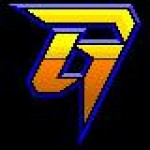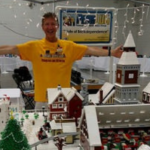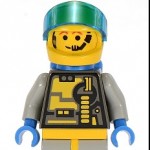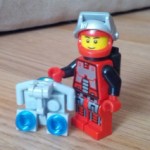Home › Forums › All Things LEGO! › What the heck is Rich building?
- This topic has 305 replies, 14 voices, and was last updated 2 years, 10 months ago by
 Rich Millich.
Rich Millich.
-
AuthorPosts
-
May 27, 2020 at 10:58 am #36437
 Rich MillichParticipant
Rich MillichParticipant5/27/2020:
This is a story of how I think through advanced color blocking.The third BL order came in, and I started sorting out parts for shaping and stickering arrangements for the pace car, the #23 car, and the #27 car. It’s possible that I can put a #55 car together too, but I’m not sure whether I have the correct color of “door with rail” parts to connect the fender wells, as I did not plan this far ahead for the #27 or #55 cars.
So let’s get into it. You see, the first part in this shaping sequence is part 50745: the Vehicle, Mudguard 4 x 2 1/2 x 1 2/3 with Arch Round. On the side of this part is the fender well, which sticks out by 1/2 a stud.
The part that connects the fender wells are 2 of part 32028, the Plate, Modified 1 x 2 with Door Rail. Placed next to the bottom of the semicircular fender well, this rail also sticks out along the side of the 1 x 2 plate by 1/2 a stud.
Together, these form runner boards down the side of the car, and the height of the rails almost match the thickness of the fender wells. From the side, it is two semicircles with a line connecting them along the side of the car. From the top, it is a 1/2 stud wide line next to the main body of the car for most of its length, forming a kind of racing stripe effect in both cases. This same height of the fender wells can extend in color plates to the front splitter under the grille and backward to the gas cap and rear brake lights area.
This forms both a unified larger shape and a color blocking option.
The problem, like many LEGO problems, is that these parts do not automatically overlap in color availability, even among the basic colors. I can solve this problem by transitioning from the front fender well to the back fender well, making these four parts (and their extensions) different colors. This works as long as most of the car around this line is the same color, a more bland backdrop for this “gradient”.
Using a variety of colors makes parts easier to acquire given the smaller numbers available in those colors, and breaks the style of large color stripes that I’ve been using thus far, so the variety might be a good development, if a bit more chunky.
In the case of the #55 car, the blue roof sticker has a fiery pattern under a white 55. Therefore, given the difficulty of creating this same fiery pattern elsewhere (as the #55 set has limited stickering in this style), one easy solution is this fender well and runner board transition from red at the front splitter and front fender well to yellow at the rear fender well and gas cap area, while making the rest of the car, in bulk, almost entirely blue. The question then is “what proportion of red, orange and blue along the car to best parallel the sticker on the roof and the other limited stickers I’ll have?” Putting the right colors in the right size and area proportions is a strength in good advanced color blocking.
With the #27, there’s a different problem. The door rail part in blue is comparatively expensive because of rarity, and I might want to break the “line” under the car, or just not use this color blocking option, by making the fender wells blue and most of the body of the car, including the runner boards, LBG. At this point, the color blocking is now LBG with blue accents, which does match some of the sticker set.
This is where LDD comes into play in livery design, rotating the car to see how the shaping shows at differing angles, in concert with having the sticker sheet in hand to mentally apply them to varying locations on the blank surfaces onscreen. Stickers change the color proportions on large surfaces, and this can create a cascading change over the surface of the car.
Anyway, that’s some of my thought processes and factors that go into building with color as combined with shaping, with multiple viewpoints on the object, to create advanced color blocking.
May 27, 2020 at 11:37 am #36438 Greg SchubertParticipant
Greg SchubertParticipantRich, you are a prolific writer, but you gotta have images to talk about color.
May 27, 2020 at 1:54 pm #36442 Matt RedfieldKeymaster
Matt RedfieldKeymasterYup. Pics, or it didn’t happen!
July 11, 2020 at 11:24 am #36599 JoshKeymaster
JoshKeymasterYup. Pics, or it didn’t happen!
July 16, 2020 at 9:01 am #36622 Rich MillichParticipant
Rich MillichParticipant7/16/2020:
Thanks for the interest, @greg, @joshhall, @philmatt24, and others, so here is the previous large post, refined, and it’s a thought process that I engage in with color and shaping. Open the pic in a different tab so you can follow along with my thinking, get a peek inside a different building style, and maybe play with these concepts yourself as a builder.The first part in my race cars I consider is part 50745: the Vehicle, Mudguard 4 x 2 1/2 x 1 2/3 with Arch Round. On the side of this part is the fender well, which sticks out by 1/2 a stud. These are the yellow and red fender wells on the #55 car below.
The part that connects the fender wells are 2 of part 32028, the Plate, Modified 1 x 2 with Door Rail. This will connedt the fender wells and act as small runner boards. Placed next to the bottom of the semicircular fender well, this rail also sticks out along the side of the 1 x 2 plate by 1/2 a stud. These are yellow and red too on the 55. I thought about doing these in orange, but the yellow and red fit better with the roof and side stickers, because the transitions on those are fairly sharp also, and don’t contain orange either.
Together, the two elements form stripes down the side of the car. They are seen from both seen from the side and above, because they stick out. From the side, this subshape is two semicircles with a line connecting them along the side of the car, and can be extended to the front splitter and the rear too, as I did here. On this #55 car, it is red to red to yellow to yellow, at the bottom of the car, front to back. From the top, it is a 1/2 stud wide line next to the main body of the car, red to yellow. This stripe can be solid or a transition like this.
This influences other color blocking options around the car based on existing shapes, or can suggest new ones. On the 55, the overhead stripe was inspired by the roof sticker; the overall stripe starts as a single red one at the front of the car, then splits to a double yellow one at the rear, similar to the flame on the sticker on the roof. Parallelism is powerful both in shape and color.
In this way, I can think about color transitions, create gradients, reinforce and contrast shaping with colors, and build a superstrong theme across the build, all at the same time. I do this with my starfighters too.
One important question then is “what proportion of red, orange and blue along the car to best parallel the sticker on the roof and the other limited stickers I’ll have?” Putting the right colors in the right size and area proportions is a strength in good advanced color blocking.
@randomdan and I have had the discussion several times that the strength of a LEGO faction is often dependent on not only the colors chosen, but a consistent proportion of those colors throughout that line, OR a steady proportion of a primary color to differing secondary colors that denote functions within that faction. This is very, very visible in Space, but it shows up in City and Town too, especially in emergency services. Am I right on this, @willmcdine? Thoughts?I think most LEGO lines are successful when they stick to a strong color proportion formula, and the line loses its strength when LEGO suddenly switches away from it in another “series”.
Designing with color blocking identity is where virtual building comes into play. In livery design, rotating the car to see how the shaping shows at differing angles, I keep varying sticker sheets in hand to mentally apply them to varying locations on the blank surfaces onscreen. Stickers change the color proportions on large surfaces, and this can create a cascading redesign over the surface of the build. With the Xtra sticker sheets being VERY useful for City and Town buildings, it’s possible to work backward from the stickers themselves now to build powerful custom modular buildings using advanced color blocking.
Hopefully this is much more descriptive and helpful, and might apply to how you structure color as part of shaping. Bases, buildings, ships, boats, cars, planes, even designing faction minifigs can be thought of this way, regardless of style.
Thoughts?
-
This reply was modified 4 years, 9 months ago by
 Rich Millich.
Rich Millich.
-
This reply was modified 4 years, 9 months ago by
 Rich Millich.
Rich Millich.
-
This reply was modified 4 years, 9 months ago by
 Rich Millich.
Rich Millich.
-
This reply was modified 4 years, 9 months ago by
 Rich Millich.
Rich Millich.
Attachments:
You must be logged in to view attached files.July 16, 2020 at 11:09 pm #36628 DanParticipant
DanParticipantI’m no color expert, but I’ll throw in my 2¢. These thoughts assume you want to make a build which looks like it would either fit in a faction or appear to be a natural evolution of one.
My favorite space factions, Blacktron and M-Tron, may look rather different from a coloring perspective, but they actually both fall into the dominant primary/dominant secondary/detail tertiary scheme. Blacktron used black/yellow/trans-red while M-Tron used red/black/gray. The major difference is Blacktron’s cockpit color (trans-yellow) is not used elsewhere while M-Trons trans-neon green is used for cockpits and emitters.
What I’ve found over my builds is that the primary color must make up the bulk of the build. The secondary usage is based on the faction. Blacktron uses it for striping and calling out details (since black and trans-red are hard to differentiate). M-Tron used the secondary color for framework and mechanics – wheels, wings, etc. Blacktron’s tertiary is used for emitters and some random “lights” while M-Tron generally uses it for greebke components.
A mistake I made with my M-Tron shed build was using gray for the base of the wall. I thought “gray=concrete” so I went with it. While he build looked nice, it didn’t evoke a strong M-Tron vibe. Good, but not great.
My Blacktron Vic, though a blockier build than I’d like, turned out nice from a color perspective with its bulk being black and including a dash of yellow stripping.
I boil it down to identifying what type of components use what particular color and stick with that. Think of bodies, greeble/engines, emitters, and canopies for spacecraft. I try to stick with that and it generally turns out well.
July 22, 2020 at 8:23 am #36642 Rich MillichParticipant
Rich MillichParticipantYeah, in Space building, color and function are more commonly and closely tied together. I know that @arcadiumsol intentionally does this to denote mechanical play feature elements and engines among other things, probably more than any of us other Spacers. @digivolution, does this happen in Star Wars LEGO sets often, or not?
This makes me think about what this means in other styles of building, like trains, Town, City, and others, and how cascading changes may affect the rest of the build.
7/22/2020:
* I tried to rip the front off of the #2 car to create more interesting shaping, but that failed, mostly because I wasn’t inventive enough under the car to leave myself enough height from fender to hood. I’ll try again tonight. This #2 car is looking worse and worse the more times I look at it. Maybe the orange and flame alternate #2 livery might make the field instead, but I like the sponsored stickering that the lime and black #2 currently has. This is one of those cases where the car looked good upon first build, but looks worse now that I’m 16 cars into this project.July 23, 2020 at 11:12 am #36654 Rich MillichParticipant
Rich MillichParticipant7/23/2020:
Another failure. This black and lime #2 car is now annoying me. Now that I’ve stickered certain parts as part of the front of the car, changing it now is limiting my options in a very annoying way. I think I’m overworking this in LDD and might do better just sitting down with real brick, taking longer, but solving the problem with a different set of tools.
July 28, 2020 at 10:59 am #36666 Rich MillichParticipant
Rich MillichParticipant7/28/2020:
Over the weekend, I completed version 1 of the #23 SpinWear car. I’ve taken to combining sticker sets of similar colors to get more sponsors onto the cars that this works for.
I’ve also completely rebuilt and responsored the #6 car, making it into a second “bad guy” car.
Finally, I’m close to responsoring the #7 in a radical rebuild to make a two car team with the #8.
Unfortunately, the stickers on the hood are not shaped to drape over the sides, so I’ll have to deploy the Kragle.
-
This reply was modified 4 years, 9 months ago by
 Rich Millich.
Rich Millich.
-
This reply was modified 4 years, 9 months ago by
 Rich Millich.
Rich Millich.
Attachments:
You must be logged in to view attached files.July 28, 2020 at 8:55 pm #36676 Greg SchubertParticipant
Greg SchubertParticipantHey Rich, this car looks pretty sweet!
July 29, 2020 at 8:12 am #36677 Rich MillichParticipant
Rich MillichParticipantThank you, @greg. This motivates me to continue.
This is the driver and firesuit livery for the #23 above. If I can find a good looking firesuit for a car, then I can buy and display a full pit crew and put this team on pit lane.
Because of the color proportions of the car, I’ll likely change his hips to blue and his right leg to white.
Attachments:
You must be logged in to view attached files.July 29, 2020 at 8:20 am #36679 Matt RedfieldKeymaster
Matt RedfieldKeymasterso I’ll have to deploy the Kragle.
Rest in peace, @zaximillian. I will remember your time as a member in good standing of Steel City LUG fondly. Yet your crimes against the Brick will be remembered as a cautionary tale for AFOL generations to come!
August 1, 2020 at 4:42 pm #36700 Rich MillichParticipant
Rich MillichParticipant8/1/2020:
I rebuilt the #6 car last week, this time merging the Dragon Dueler set with a smaller sticker set of a different car that happened tp have a #6 in similar colors. Here is the pic.
This car might be a second “bad guy” car for the Blaster Boys. It also could use a touch of yellow to parallel the yellow outline on the hood.
This is why these cars are solid version 1, but could yet be refined a little as I go.
-
This reply was modified 4 years, 8 months ago by
 Rich Millich.
Rich Millich.
Attachments:
You must be logged in to view attached files.August 2, 2020 at 1:57 pm #36709 Rich MillichParticipant
Rich MillichParticipantHere’s a contrast between the old #7 versus the new #7 that I built last week. The old #7 is going to be cannibalized for the #18 today.
Attachments:
You must be logged in to view attached files.August 2, 2020 at 2:01 pm #36711 Rich MillichParticipant
Rich MillichParticipantThis is the new #7 alongside the #8. I decided to build these two cars as close to the same as possible since the stickers are parallel. Now this is a two car team.
Attachments:
You must be logged in to view attached files.August 2, 2020 at 9:22 pm #36713 DanParticipant
DanParticipantI’m really liking #6. It’s interesting to see how the shaping evolved with #7 – those panels by the driver give it a nice look! The spoiler details are interesting. That seems like a place there wouldn’t be much detail, but on these builds it’s never boring.
August 8, 2020 at 1:05 pm #36756 Rich MillichParticipant
Rich MillichParticipant8/8/2020:
* Reshaped the #2 successfully.
* Almost finished the #18. I am missing two stickered parts.
*Almost finished the #21. I am short a matched set of green 2×3 wedge plates.
* I DID finish building the #71, which is in the Octan stable of racers. Pretty aggressive shaping on the nose and hood, and I’m learning how to mix a fourth color onto a car.
Attachments:
You must be logged in to view attached files.August 9, 2020 at 3:40 pm #36774 Rich MillichParticipant
Rich MillichParticipant8/9/2020:
Spent most of today working out which cars are closest to possibly complete based on the parts I have left:
#27, an LBG/Blue car adapted from a McDonald’s set
#31, a black/red/lime car adapted from a speedboat racer
#77, a blue/white/red car
#43, an orange/DBG car that I’ll convert from the McLaren Speed Champions car with the unmarked parts
#42, a red/white/black car
The Pace Car/Track Marshal
and of course, the uncomplete #18, #21 and #78 cars, where I’m short by only a handful of parts each.I’m at the point where I can work on a choice of cars that interest me at the time, and figs are due to arrive to fill in some of the drivers and pit crews.
August 9, 2020 at 3:45 pm #36775 Greg SchubertParticipant
Greg SchubertParticipantHey Rich, did you get any awards at the virtual LUG meeting yesterday?
Attachments:
You must be logged in to view attached files.August 10, 2020 at 6:09 am #36777 Rich MillichParticipant
Rich MillichParticipantI did not attend. I did see the TLDR award on Flickr. What is this other one?
August 10, 2020 at 9:04 am #36778 Greg SchubertParticipant
Greg SchubertParticipantWhat is this other one?
SteelCity Award for Racecar Building, aka the coveted SCARB trophy, not to be confused with the Stanley Cup, which is also highly prized
August 10, 2020 at 10:01 am #36779 Rich MillichParticipant
Rich MillichParticipantWhat is this other one?
SteelCity Award for Racecar Building, aka the coveted SCARB trophy, not to be confused with the Stanley Cup, which is also highly prized
Not by the Penguins, apparently.
August 10, 2020 at 10:04 am #36780 Rich MillichParticipant
Rich MillichParticipant8/10/2020:
Ideas are accelerating. I realized that I was developing two racecars that needed each other.
One is in yellow and red with a sun motif and the number 33, but no sponsor. The other is in red and black with yellow flames, an Airborne Spoilers sponsor and figs with detailed torsos, but no car number.
The solution is obvious. Merge them. Now the #33 is in play.
August 11, 2020 at 11:44 am #36785 Rich MillichParticipant
Rich MillichParticipant8/11/2020:
With some more digging on BrickLink, I found three more numbered parts that were associated with LEGO non-IP racing vehicles: #34, #52 and #73. It looks like #34 and #52 are a natural two car team.
I’m totally okay with designing and building these too, as I’m on a roll now.
As for building, right now, I think I’ll just pick a car that interests me while I wait for the final #18 and #21 cars to come in. I like the #33 right now, as I have more parts for it than the others. On the 33, I’m interested in merging the stickered parts and color blocking of two different sets as I did on the #6. In addition, the #33 will come with a detailed torso for driver, and this means pit crew eventually.
On the bad side, a larger number of cars are trending toward red, black, yellow and white, so I need to keep the color blocking fresh between them. Thankfully, the existing Octan team of four cars taught me that I can split the color blocking between front and back, left and right, or offset the striping along the car to place one stripe off center. The more cars I do, the more options I discover.
Maybe I’ll build the #33 in slow motion and post the steps and design process here, since I’m just now in that beginning stage with it.
-
This reply was modified 4 years, 8 months ago by
 Rich Millich.
Rich Millich.
August 11, 2020 at 12:10 pm #36789 Rich MillichParticipant
Rich MillichParticipantI’m really liking #6. It’s interesting to see how the shaping evolved with #7 – those panels by the driver give it a nice look! The spoiler details are interesting. That seems like a place there wouldn’t be much detail, but on these builds it’s never boring.
I had to give that some thought: “Am I overdoing the spoilers?”
No, I don’t think so. Since others seem to like the variance in them, and they are a significant surface area of each car, I can change the shaping as I like.The whole race field has kind of a Grand Touring (GT) V8 vibe to it. Within this race field, I see the cars as a junction between modified production models, prototypes, and next-gen racing fiction.
I do plan to also build at least one production model of one of these racers, probably in green with a white hardtop. I know @joshhall was looking for cars for the cityscape, and it might also be interesting to “cool down” a few of these models as production sportscars. I discussed this with @randomdan, so maybe a modular dealership too?
Further down the road, I’d like to try to integrate a GT Grand Prix in with a cityscape at one of our displays, and simulate a race during that event, just moving cars around, changing the position pole, that kind of thing.
-
This reply was modified 4 years, 9 months ago by
-
AuthorPosts
- You must be logged in to reply to this topic.
